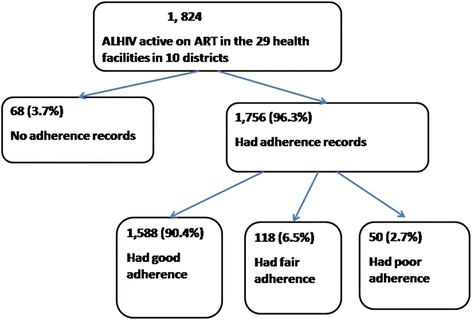Adherence to antiretroviral therapy and retention in care for adolescents living with HIV from 10 districts in Uganda
- PMID: 26573923
- PMCID: PMC4647509
- DOI: 10.1186/s12879-015-1265-5
Adherence to antiretroviral therapy and retention in care for adolescents living with HIV from 10 districts in Uganda
Abstract
Background: Adolescents have gained increased attention because they are the only age group where HIV related mortality is going up. We set out to describe the level and factors associated with adherence to antiretroviral therapy (ART) as well as the 1 year retention in care among adolescents in 10 representative districts in Uganda. In addition, we explored the barriers and facilitators of adherence to ART among adolescents.
Methods: The study involved 30 health facilities from 10 representative districts in Uganda. We employed both qualitative and quantitative data collection methods in convergent design. The former involved Focus group discussions with adolescents living with HIV, Key informant interviews with various stakeholders and in depth interviews with adolescents. The quantitative involved using retrospective records review to extract the last recorded adherence level from all adolescents who were active in HIV care. Factors associated with adherence were extracted from the ART cards. For the 1 year retention in care, we searched the hospital records of all adolescents in the 30 facilities who had started ART 1 year before the study to find out how many were still in care.
Results: Out of 1824 adolescents who were active on ART, 90.4 % (N = 1588) had ≥95 % adherence recorded on their ART cards at their last clinic visit. Only location in rural health facilities was independently associated with poor adherence to ART (P = 0.008, OR 2.64 [1.28 5.43]). Of the 156 adolescents who started ART, 90 % (N = 141) were still active in care 1 year later. Stigma, discrimination and disclosure issues were the most outstanding of all barriers to adherence. Other barriers included poverty, fatigue, side effects, pill burden, depression among others. Facilitators of adherence mainly included peer support groups, counseling, supportive health care workers, short waiting time and provision of food and transport.
Conclusion: Adherence to ART was good among adolescents. Being in rural areas was associated with poor adherence to ART and 1 year retention in care was very good among adolescents who were newly started on ART. Stigma and disclosure issues continue to be the main barriers to adherence among adolescents.
Figures
Similar articles
-
Facilitators and Barriers to Adherence to Antiretroviral Therapy and Retention in Care Among Adolescents Living with HIV/AIDS in Zambia: A Mixed Methods Study.AIDS Behav. 2019 Sep;23(9):2618-2628. doi: 10.1007/s10461-019-02533-5. AIDS Behav. 2019. PMID: 31093820
-
Facilitators and barriers to uptake and adherence to lifelong antiretroviral therapy among HIV infected pregnant women in Uganda: a qualitative study.BMC Pregnancy Childbirth. 2017 Mar 21;17(1):94. doi: 10.1186/s12884-017-1276-x. BMC Pregnancy Childbirth. 2017. PMID: 28320347 Free PMC article.
-
"How am I going to live?": exploring barriers to ART adherence among adolescents and young adults living with HIV in Uganda.BMC Public Health. 2018 Oct 4;18(1):1158. doi: 10.1186/s12889-018-6048-7. BMC Public Health. 2018. PMID: 30286746 Free PMC article. Clinical Trial.
-
ART Adherence Among Malawian Youth Enrolled in Teen Clubs: A Retrospective Chart Review.AIDS Behav. 2019 Sep;23(9):2629-2633. doi: 10.1007/s10461-019-02580-y. AIDS Behav. 2019. PMID: 31292826 Review.
-
Mapping patient-identified barriers and facilitators to retention in HIV care and antiretroviral therapy adherence to Andersen's Behavioral Model.AIDS Care. 2015;27(7):817-28. doi: 10.1080/09540121.2015.1009362. Epub 2015 Feb 11. AIDS Care. 2015. PMID: 25671515 Free PMC article. Review.
Cited by
-
Perceived Stigma and Fear of Unintended Disclosure are Barriers in Medication Adherence in Adolescents with Perinatal HIV in Botswana: A Qualitative Study.Biomed Res Int. 2019 Dec 2;2019:9623159. doi: 10.1155/2019/9623159. eCollection 2019. Biomed Res Int. 2019. PMID: 31886271 Free PMC article.
-
Discourses of Mental Wellness Among Adolescents Living with HIV in Cape Town, South Africa.Psychol Res Behav Manag. 2022 Jun 8;15:1435-1450. doi: 10.2147/PRBM.S360145. eCollection 2022. Psychol Res Behav Manag. 2022. PMID: 35702635 Free PMC article.
-
Lessons learned from a mobile technology-based intervention informed by behavioral economics to improve ART adherence among youth in Uganda.AIDS Care. 2020 May;32(5):616-622. doi: 10.1080/09540121.2019.1622630. Epub 2019 May 28. AIDS Care. 2020. PMID: 31137959 Free PMC article.
-
Peer Support for Adolescents and Young People Living with HIV in sub-Saharan Africa: Emerging Insights and a Methodological Agenda.Curr HIV/AIDS Rep. 2019 Dec;16(6):467-474. doi: 10.1007/s11904-019-00470-5. Curr HIV/AIDS Rep. 2019. PMID: 31776974 Free PMC article. Review.
-
Longitudinal Trajectories of Antiretroviral Treatment Adherence and Associations With Durable Viral Suppression Among Adolescents Living With HIV in South Africa.J Acquir Immune Defic Syndr. 2024 Jun 1;96(2):171-179. doi: 10.1097/QAI.0000000000003408. J Acquir Immune Defic Syndr. 2024. PMID: 38771754 Free PMC article.
References
-
- UNAIDS . Joint United Nations Programme on HIV/AIDS. Global report. UNAIDS report on the global AIDS epidemic 2013. Geneva, Switzerland: UNAIDS; 2013.
-
- UNICEF . Opportunity in crisis: preventing HIV from early adolescence to young adulthood. UNICEF. 2011.
-
- UNAIDS. JUNPoHA . Global report: UNAIDS report on the global AIDS epidemic 2010. Geneva: UNAIDS; 2010.
-
- WHO . HIV and adolescents: guidance for HIV testing and counseling and care for adolescents living with HIV: recommendations for a public health approach and considerations for policy-makers and managers, Geneva Switzerland. 2013. - PubMed
Publication types
MeSH terms
LinkOut - more resources
Full Text Sources
Other Literature Sources
Medical


